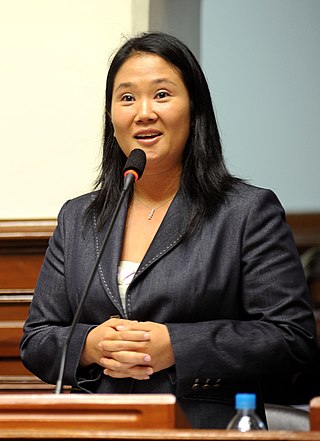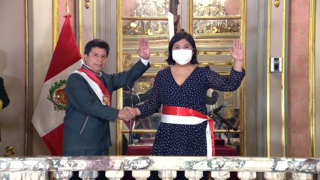The politics of the Republic of Peru takes place in a framework of a unitary semi-presidential representative democratic republic, whereby the President of Peru is both head of state and head of government, and of a pluriform multi-party system. Executive power is exercised by the President and the Government. Legislative power is vested in both the Government and the Congress. The Judiciary is independent of the executive and the legislature. The Economist Intelligence Unit rated Peru a "hybrid regime" in 2022.

The Peruvian Armed Forces are the military services of Peru, comprising independent Army, Navy and Air Force components. Their primary mission is to safeguard the country's independence, sovereignty and territorial integrity against any threat. As a secondary mission they participate in economic and social development as well as in civil defense tasks.

Alberto Kenya Fujimori Inomoto was a Peruvian politician, professor, and engineer who served as the 54th president of Peru from 1990 to 2000. Of Japanese descent, Fujimori was an agronomist and university rector before entering politics. Generally recognized as a dictator, his government was characterized by its use of propaganda, neoliberal economic reforms, widespread political corruption and human rights violations.

Peru, officially the Republic of Peru, is a country in western South America. It is bordered in the north by Ecuador and Colombia, in the east by Brazil, in the southeast by Bolivia, in the south by Chile, and in the south and west by the Pacific Ocean. Peru is a megadiverse country with habitats ranging from the arid plains of the Pacific coastal region in the west to the peaks of the Andes mountains extending from the north to the southeast of the country to the tropical Amazon basin rainforest in the east with the Amazon River. Peru has a population of over 32 million, and its capital and largest city is Lima. At 1,285,216 km2 (496,225 sq mi), Peru is the 19th largest country in the world, and the third largest in South America.

Keiko Sofía Fujimori Higuchi is a Peruvian politician. Fujimori is the eldest daughter of former Peruvian president Alberto Fujimori and Susana Higuchi. From August 1994 to November 2000, she held the role of First Lady of Peru, during her father's administrations. She has served as the leader of the Fujimorist political party Popular Force since 2010, and was a congresswoman representing the Lima Metropolitan Area, from 2006 to 2011. Fujimori ran for president in the 2011, 2016, and 2021 elections, but was defeated each time in the second round of voting.

Hilaria Supa Huamán is a Peruvian politician, human rights activist, and an active member of several Indigenous women's organizations in Peru and around the world. She was a Congresswoman representing Cusco from 2006-2011, as a member of Ollanta Humala's Partido Nacionalista Peruano party.
Racism in Mexico refers to the social phenomenon in which behaviors of discrimination, prejudice, and any form of antagonism are directed against people in that country due to their race, ethnicity, skin color, language, or physical complexion. It may also refer to the treatment and sense of superiority of one race over another.

Fujimorism is the policies and the political ideology of former President of Peru Alberto Fujimori as well as the personality cult built around him, his policies and his family, especially Keiko Fujimori. The ideology is defined by authoritarianism, its support for neoliberal economics, opposition to communism, and socially and culturally conservative stances such as opposition to LGBT rights and school curriculums including gender equality or sex education. Opponents of Fujimorism are known as anti-Fujimorists.

Women in Peru represent a minority in both numbers and legal rights. Although historically somewhat equal to men, after the Spanish conquest the culture in what is now Peru became increasingly patriarchal. The patriarchal culture is still noticeable. Contraceptive availability is not enough for the demand, and over a third of pregnancies end in abortion. Maternal death rates are also some of the highest in South America.

The National Population Program, known as the National Program for Reproductive Health and Family Planning from 1996 to 1998, was a project conducted in Peru in through the 1990s to reduce population growth as a way of meeting international demographic standards. Plans for the "total extermination" of impoverished Peruvians through sterilization were included in Plan Verde, a covert military operation created to establish a neoliberal military junta. Compulsory sterilization, which is a method that forces individuals to partake in sterilization operations, was the main method employed by the Peruvian government to decrease population.

Alberto Fujimori's government used forced sterilization to control the population of impoverished and indigenous women in Peru, mainly in rural Andean communities. This practice was part of the state-led National Population Program, which emerged from the military's Plan Verde, initially aimed at economic recovery and combating the Shining Path insurgency. The program has been widely condemned as a form of ethnic cleansing or genocide due to its disproportionate impact on rural and indigenous peoples.

Since 2016, Peru has been plagued with political instability and a growing crisis, initially between the President, Pedro Pablo Kuczynski and Congress, led de facto by Keiko Fujimori. The crisis emerged in late 2016 and early 2017 as the polarization of Peruvian politics increased, as well as a growing schism between the executive and legislative branches of government. Fujimori and her Fujimorist supporters would use their control of Congress to obstruct the executive branch of successive governments, resulting with a period of political instability in Peru.

Esther Pineda G., often published as Esther Pineda, is a Venezuelan sociologist and feminist writer. She has written sociological studies, essay collections, and poetic anthologies about misogyny in the history of Western philosophy, the connection between machismo and violence against women, and racial discrimination, particularly against Afro-Venezuelans. Pineda holds a PhD in sociology, and her writing frequently uses tools of sociological analysis.
Racism in Chile encompasses any type of racial or ethnic discrimination by a group of inhabitants or organizations of that country against groups from other nations or the same nation. The origins of Chilean racism, and that of other Latin American nations, can be traced back to 16th century colonialism under the rule of the Spanish Empire. In the establishment of imperial rule, Native Americans experienced extermination, slavery and forced miscegenation.

Plan Verde was a clandestine military operation developed by the armed forces of Peru during the internal conflict in Peru; it involved the control or censorship of media in the nation and the establishment of a neoliberal economy controlled by a military junta in Peru. Initially drafted in October 1989 in preparation for a coup d'état to overthrow President Alan García, the plan was substantively implemented after the victory of political outsider Alberto Fujimori in the 1990 Peruvian general election, and subsequent 1992 Peruvian self-coup d'état. Plan Verde was first leaked to the public by Peruvian magazine Oiga, shortly after the coup, with a small number of other media outlets also reporting access to the plan's documents.
The "Lima Consensus", a term attributed to Harvard University's government professor, Steven Levitsky, refers to a set of economic policies that have predominated in Peru starting from the presidency of Alberto Fujimori. This term was fashioned analogously to the "Washington Consensus." Defined by its neoliberal, deregulatory stance and a export-led growth emphasizing raw materials, the Lima Consensus is based on free market capitalism. Peru's economic elites expressly support these economic policies.

Following the ousting of president of Peru, Pedro Castillo on 7 December 2022, a series of political protests against the government of president Dina Boluarte and the Congress of Peru occurred. The demonstrations lack centralized leadership and originated primarily among grassroots movements and social organizations on the left to far-left, as well as indigenous communities, who feel politically disenfranchised. Castillo was removed from office and arrested after announcing the illegal dissolution of Congress, the intervention of the state apparatus, and the forced establishment of an "emergency government", which was characterized as a self-coup attempt by all government institutions, all professional institutions, and mainstream media in Peru while Castillo's supporters said that Congress attempted to overthrow Castillo. Castillo's successor Dina Boluarte, along with Congress, were widely disapproved, with the two receiving the lowest approval ratings among public offices in the Americas. Among the main demands of the demonstrators are the dissolution of Congress, the resignation of Boluarte, new general elections, the release of Castillo, and the formation of a constituent assembly to draft a new constitution. It has also been reported that some of the protesters have declared an insurgency in Punos's region. Analysts, businesses, and voters said that immediate elections are necessary to prevent future unrest, although many establishment political parties have little public support.

The third presidential vacancy (impeachment) process against President Pedro Castillo was an action initiated by the Congress of the Republic of Peru with the purpose of declaring the "permanent moral incapacity" of the President of the Republic, Pedro Castillo, under Article 113 of the Political Constitution of Peru.

Conservatism in Peru is a broad system of conservative political beliefs in Peru, characterized by support for Catholic values, social stability and social order. Peruvian conservatism has encompassed a wide range of theories and ideologies in the last two hundred years. In contrast with nearly nations like Colombia or Chile, Peru has not developed a concrete conservative political tradition.

The propaganda used by Fujimorists both during and after the government of Alberto Fujimori left long-standing effects in politics of Peru, resulting with increased power amongst Fujimorists, conservatives and social elites within the nation.



















